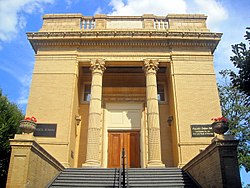Volta Laboratory and Bureau
From Wikipedia, the free encyclopedia
Not to be confused with the Bell Laboratories, created by AT&T in 1925.
Volta Bureau
| |
 | |
|
| |
| Location | 3414 Volta Pl., NW Washington, D.C. |
|---|---|
| Coordinates | 38°54′34″N 77°4′9″WCoordinates: 38°54′34″N 77°4′9″W |
| Built | (1885) 1893 |
| Architect | Peabody and Stearns |
| Architectural style | Neoclassical |
| NRHP Reference # | 72001436 |
| Significant dates | |
| Added to NRHP | November 28, 1972[1] |
| Designated NHL | November 28, 1972[2] |
The Volta Laboratory (also known as the "Alexander Graham Bell Laboratory", the "Bell Carriage House" and the "Bell Laboratory") and theVolta Bureau were created in Georgetown, Washington, D.C. by Alexander Graham Bell.[3]
The Volta Laboratory was founded in 1880–1881 with Charles Sumner Tainter and Bell's cousin, Chichester Bell,[4] for the research and development of telecommunication, phonograph and other technologies.
Using funds generated by the Volta Laboratory, Bell later founded the Volta Bureau in 1887 "for the increase and diffusion of knowledge relating to the deaf", and merged with the American Association for the Promotion and Teaching of Speech to the Deaf (AAPTSD) in 1908.[5] It was renamed as the Alexander Graham Bell Association for the Deaf in 1956 and then the Alexander Graham Bell Association for the Deaf and Hard of Hearingin 1999.[6]


No comments:
Post a Comment